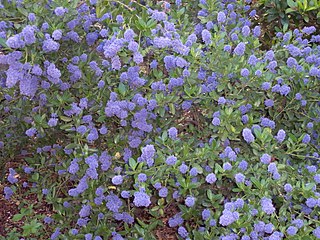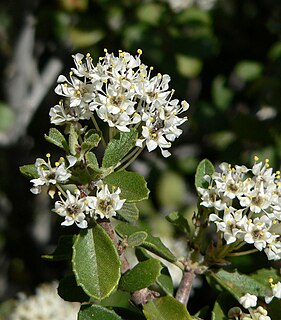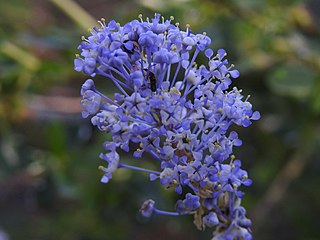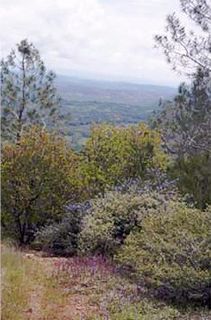
Ceanothus is a genus of about 50–60 species of nitrogen-fixing shrubs and small trees in the buckthorn family (Rhamnaceae). Common names for members of this genus are buckbrush, California lilac, soap bush, or just ceanothus. "Ceonothus" comes from Ancient Greek: κεάνωθος (keanōthos), which was applied by Theophrastus to an Old World plant believed to be Cirsium arvense.

Ceanothus integerrimus, known by the common name deer brush, is a species of woody shrub in the family Rhamnaceae, native to the western United States in Arizona, New Mexico, California, Oregon, and Washington. It grows in montane chaparral and woodlands regions, in hardwood forests, and in fir, spruce, and Ponderosa pine plant communities, being most abundant in the California chaparral and woodlands and Sierra Nevada.

Ceanothus arboreus is a species of perennial shrub to small tree in the family Rhamnaceae, commonly known as the felt-leaf ceanothus, island ceanothus, and island mountain lilac. It is the largest member of the California lilacs, and is characterized with glossy, dark green foliage that is adorned by pale blue to white flowers in bloom. It is endemic to the Channel Islands of California and Guadalupe Island in Mexico, only being re-discovered on Guadalupe Island after the elimination of feral goats.

Ceanothus thyrsiflorus, known as blueblossom or blue blossom ceanothus, is an evergreen shrub in the buckthorn family Rhamnaceae that is endemic to Oregon and California in the US. The term 'Californian lilac' is also applied to this and other varieties of ceanothus, though it is not closely related to Syringa, the true lilac.

Ceanothus griseus is a species of flowering shrub known by the common names Carmel ceanothus and Carmel creeper. 'Carmel' refers to the Carmel-by-the-Sea region in California.

Ceanothus ophiochilus is a rare species of flowering shrub known by the common name Vail Lake ceanothus, native to Southern California. It was not described until 1991.
The South Sierra Wilderness is a federally designated wilderness area in the Southern Sierra Nevada, in eastern California. It is located 65 miles (105 km) northeast of Bakersfield, and is southwest of Owens Lake and Olancha.

Ceanothus spinosus, with the common names greenbark and redheart, is a species of Ceanothus. It is native to southern California and northern Baja California, where it grows in the scrub and chaparral of the coastal mountain ranges.

Ceanothus confusus is a species of shrub in the family Rhamnaceae known by the common name Rincon Ridge ceanothus. It is endemic to northern California where it grows in the coastal mountains north of the San Francisco Bay Area. Its habitats include coniferous forest, woodland, and chaparral. This is a low, spreading shrub often forming a short mat up to about 1.2 meters wide. The stem is gray-brown with new twigs having a reddish color and fuzzy texture. The evergreen leaves are oppositely arranged. Each is up to 2 centimeters long and oval in shape with 3 to 5 large teeth. The upper surface is shiny green and the underside is paler and feltlike in texture with hairs along the veins. The inflorescence is a small cluster of blue or purple flowers. The fruit is a horned capsule about half a centimeter wide.

Ceanothus cordulatus is a species of shrub in the family Rhamnaceae known by the common names mountain whitethorn and whitethorn ceanothus. It is native to California and adjacent sections of Oregon, Nevada, and Baja California, where it grows on mountain ridges and other forested areas. This is a spreading shrub growing usually wider than tall and up to about 1.5 meters. The stems are gray, with the twigs yellow-green in color and fuzzy in texture when new. The evergreen leaves are alternately arranged and up to 3 centimeters long. Each is oval in shape with three ribs and generally not toothed. The leaves may be hairy or not. The inflorescence is panicle-shaped, up to about 4 centimeters long. The flowers are white to off-white with five sepals and five petals. The fruit is a rough, ridged capsule up to half a centimeter long. It has three valves inside, each containing a seed. It is a nitrogen-fixing plant, that is uniquely abundant in old-growth forest conditions when compared to similar types of nitrogen-fixing plants. In addition, Ceanothus cordulatus is known to be an important source of nitrogen patches for significantly longer times than other similar post-disturbance successional shrubs, following disturbance events such as forest fires.

Ceanothus ferrisiae is a rare species of shrub in the family Rhamnaceae. Its common name is coyote ceanothus.

Ceanothus gloriosus is a species of shrub in the family Rhamnaceae known by the common name Point Reyes ceanothus. It is endemic to California, where it is known from the coastline of the San Francisco Bay Area and areas north and south. It grows on seaside bluffs and the slopes of the coastal mountains. This shrub grows flat and spreading to erect, approaching two meters in maximum size. The evergreen leaves are oppositely arranged and up to 5 centimeters long, rounded to oval in shape. The edges are toothed, the teeth sometimes spine-tipped. The inflorescence is a small cluster of bright blue to purple flowers. The fruit is a horned capsule about 4 millimeters wide.

Ceanothus pauciflorus, known by the common name Mojave ceanothus, is a species of flowering shrub in the buckthorn family, Rhamnaceae. It is native to the Southwestern United States and Mexico, where it grows primarily in shrubland communities at moderate to high elevations. It is characterized by oppositely arranged leaves, corky stipules and white flowers. It was formerly known as Ceanothus greggii.

Ceanothus jepsonii is a species of shrub in the family Rhamnaceae known by the common names musk brush and Jepson ceanothus.

Ceanothus maritimus, with the common name maritime ceanothus, is a species of shrub in the buckthorn family Rhamnaceae. It is endemic to San Luis Obispo County, California, where it is known from only a few occurrences in the vicinity of Hearst Ranch. It shares the same range as the similarly rare Ceanothus hearstiorum, growing on the coastal bluffs.

Ceanothus parvifolius is a species of shrub in the family Rhamnaceae known by the common name littleleaf ceanothus or littleleaf whitethorn. This deciduous plant is characterized by its blue flowers and flat topped habit, and is endemic to the Sierra Nevada of California, where it grows on mountain flats and coniferous forest.

Ceanothus roderickii is a rare species of shrub in the family Rhamnaceae known by the common name Pine Hill ceanothus. It is endemic to western El Dorado County, California, where it grows in the chaparral and woodlands of the Sierra Nevada foothills, such as the Pine Hill Ecological Reserve. It is named after 20th century California flora explorer, botanist, and arboretum director Wayne Roderick.

Ceanothus sonomensis, with the common name Sonoma ceanothus, is a rare species of shrub in the family Rhamnaceae. It is endemic to northern California.

Ceanothus verrucosus is a species of shrub in the family Rhamnaceae known by the common names wart-stem ceanothus, barranca brush, coast lilac and white coast ceanothus. It is endemic to northwestern Baja California and San Diego County, where it grows in coastal sage scrub and coastal succulent scrub habitats. It is considered a rare species north of the international border, as most of the valuable coastal land that hosts this plant in the San Diego area has been claimed for development. In California, several extant populations still remain scattered around the region, such as one protected at Torrey Pines.

Pine Hill Ecological Reserve is a nature reserve of 403 acres (1.63 km2) located due east of Folsom Lake in the Sierra Nevada foothills, in El Dorado County, California. The reserve was established in 1979, and is managed by the California Department of Fish and Game.




















